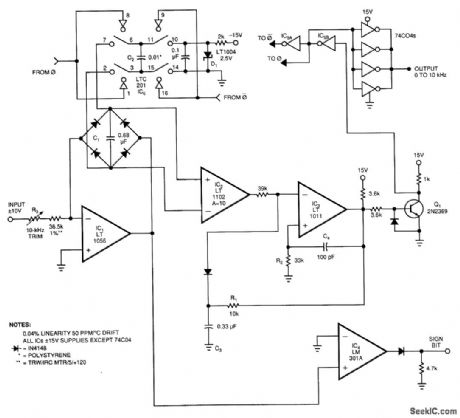Basic Circuit
VOLTAGE-TO_FREQUENCY_CONVERTER_II
Published:2009/7/11 5:24:00 Author:May | From:SeekIC

This voltage-to-frequency converter (VFC) accepts the bipolar-ac inputs. For -10- to + 10-V inputs, the converter produces a proportional 0- to 10-kHz output. Linearity is 0.04%, and temperature coefft-cient (TC) measures about 50 ppm/ °C.To understand the circuit, assume that its input sees a bipolar square wave. During the input's positive phase, IC1's output swings negative and drives current through C1 via the full-wave diode bridge. IC1's current causes C1's voltage to ramp up linearity. Instrumentation amplifier IC2 operates at a gain of 10 and measures the differential voltage across C1.IC2's output biases comparator IC3's negative input. When IC2's output crosses zero, IC3 fires ac positive feedback to IC3's positive input and hangs up IC3's output for about 20 μs. The Q1 level shifter drives ground-referred inverters IC5A and IC5B to deliver biphase drive to LT1004 switch IC6.IC6, configured as a charge pump, places C2 across C1 each time the inverters switch, which resets C1 to a lower voltage. The LT1004 reference (D1), along with C2's value, determines how much charge the charge pump removes from C1 each time the charge pump cycles. Thus, each time IC2's output tries to cross zero, the charge pump switches C2 across C1, which resets C1 to a small negative voltage and forces IC1 to begin recharging C1. The frequency of this oscillatory behavior is directly proportional to the input-derived current into IC1. During the time that C1 is ramping toward zero, IC6, places C2 across the reference diode (D1), and prepares C2 for the next discharge cycle. The action is the same for negative-input excursions, except that IC1's output phasing is reversed. IC2, looking differentially across IC1's diode bridge, sees the same signal as it does for positive inputs; therefore, the circuit's action is identical. IC4, detecting IC1's output polarity, provides a signal bid output.
Reprinted Url Of This Article:
http://www.seekic.com/circuit_diagram/Basic_Circuit/VOLTAGE-TO_FREQUENCY_CONVERTER_II.html
Print this Page | Comments | Reading(3)

Article Categories
power supply circuit
Amplifier Circuit
Basic Circuit
LED and Light Circuit
Sensor Circuit
Signal Processing
Electrical Equipment Circuit
Control Circuit
Remote Control Circuit
A/D-D/A Converter Circuit
Audio Circuit
Measuring and Test Circuit
Communication Circuit
Computer-Related Circuit
555 Circuit
Automotive Circuit
Repairing Circuit
Code: